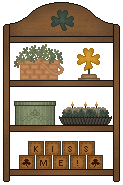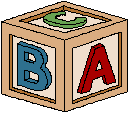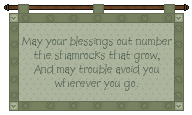~St. Patrick's Day
is celebrated around the world on March 17th~

Saint Patrick was a Christian Missionary to Ireland.

"Go into all the world and preach the good
news."
~ Mark 16:15 ~
WHAT IS A MISSIONARY?
Webster's
Dictionary Says: missionary noun 1: someone
who attempts to convert others to a particular doctrine
or program 2: someone sent on a mission--especially a
religious or charitable mission to a foreign country

Missions
Links:
The Bible says that we as
Christians and Believers are saints:
"To
all in Rome who are loved by God and called to be saints:
Grace and peace to you from God our Father and from the
Lord Jesus Christ." ~Romans
1:7~
"And
he who searches our hearts knows the mind of the Spirit,
because the Spirit intercedes for the saints in
accordance with God's will." ~Romans
8:27~
"I
ask you to receive her in the Lord in a way worthy of the
saints and to give her any help she may need from you,
for she has been a great help to many people, including
me." ~Romans 16:2~
"Paul,
an apostle of Christ Jesus by the will of God, To the
saints in Ephesus, the faithful in Christ Jesus:" ~Ephesians
1:1~
"I
pray also that the eyes of your heart may be enlightened
in order that you may know the hope to which he has
called you, the riches of his glorious inheritance in the
saints," ~Ephesians 1:18~
To
read all the references of SAINTS in the Bible click the
word SAINTS here.
We as Christians are to:
"Study
to show thyselves approved unto GOD, a workman that
needeth not to be ashamed rightly dividing the word of
God". ~2 Timothy 2:15~
"Prove
all things, hold fast that which is good" ~1
Thessalonians 5:12~
I
am a Christian, I am not Catholic. Some Catholics are
Christians and some Christians are Catholics. But one
does not equal the other. Being a Baptist or Pentecostal
does not necessarily mean that you are a Christian, for
that matter being any denomination does not mean that you
are a Christian.
I
have included the links below for purely educational
purposes. I personally found it very interesting to know
how the Roman Catholic Church decides to make a person a
Saint.
Related
Links:
This is what the Catholic Church says about St Patrick & How does the
Catholic Church choose Saints?
And a Chick Track about: Praying to Saints what does the
Bible really say.
Billy Graham answers this question: What is a saint, in
your opinion? I grew up thinking only a very
few people were
entitled to be called saints, but a friend of mine says
every Christian is a saint.
WHAT IS A CHRISTIAN?

Webster's
Dictionary Says: Christian
\Chris"tian\, a. 1. Pertaining to Christ or his
religion; as, Christian people. 2. Pertaining to the
church; ecclesiastical; as, a Christian court.
--Blackstone. 3. Characteristic of Christian people;
civilized; kind; kindly; gentle; beneficent.
This
is what the Bible says:

Acts 11:26 "and when he
had found him, he brought him unto Antioch. And it came
to pass, that even for a whole year they were gathered
together with the church, and taught much people, and
that the disciples were called Christians first in
Antioch."
Acts 26:28 "And Agrippa
[said] unto Paul, With but little persuasion thou
wouldest fain make me a Christian."
1 Peter 4:16 "but if [a man
suffer] as a Christian, let him not be ashamed; but let
him glorify God in this name".
Easton's Bible
Dictionary defines a Christian - the
name given by the Greeks or Romans, probably in reproach,
to the followers of Jesus. It was first used at Antioch.
The names by which the disciples were known among
themselves were "brethren," "the
faithful," "elect," "saints,"
"believers." But as distinguishing them from
the multitude without, the name "Christian"
came into use, and was universally accepted. This name
occurs but three times in the New Testament (Acts 11:26;
26:28; 1 Pet. 4:16).
Now that we know what a
Christian is by definition let's look at how we can
become a Christian:
"For by GRACE are you
saved through faith, it is a gift of God not of works
lest any man should boast" ~Ephesians
2:8-9~
It's as easy as ABC to
give your heart  to the Lord. to the Lord.

All you have to do is:
Admit you
are a sinner. Romans
3:23
Believe Jesus
died on the cross for you. Acts
16:31
Confess your
sin to God and turn from it.
Romans 10:9
All
the "LUCK" in the world won't
matter if you spend eternity in hell. Don't put it
off......you don't know what tomorrow may bring. Do you
know what you would say if you tomorrow you died, you got
to heaven and they asked you "Why should we let you
in?" Believe me a long laundry list of all the good
things you did isn't enough. Because nothing of your own
merit will get you to heaven.....the only way is by
accepting Jesus Christ as your Savior.
Here
is a link to "The Four Spiritual
Laws" part of Campus Crusade for Christ. This page and
site will follow up on your decision if you become a
Christian and they have wonderful resources. You can
click here and read my personal testimony at "Annie's
Testimony Page".
 

 One
traditional icon of the day is the Shamrock. One
traditional icon of the day is the Shamrock. 
And
this stems from a more bona fide Irish tale that tells
how Patrick used the three-leafed shamrock to explain the
Trinity. He used it in his sermons to represent how the
Father, the Son, and the Holy Spirit could all exist as
separate elements of the same entity. His followers
adopted the custom of wearing a shamrock on his feast
day. ~Excerpted from Compton's
Encyclopedia ~

WHAT
IS THE TRINITY?
Father ~ Son ~ Holy Spirit
The
Apple is also another illustration of the Trinity. Core,
Skin and the meat or fruit. Three separate parts that
make up the apple.
Many
Christians agree and others disagree with this
"doctrine" of the Trinity. I am not saying I
agree or disagree but I am trying to give you the
information and then you can decide what you think.
Easton's Bible
Dictionary defines the Trinity - a word not found
in Scripture, but used to express the doctrine of the
unity of God as subsisting in three distinct Persons.
This word is derived from the Gr. trias, first used by
Theophilus (A.D. 168-183), or from the Lat. trinitas,
first used by Tertullian (A.D. 220), to express this
doctrine. The propositions involved in the doctrine are
these: 1. That God is one, and that there is but one God
(Deut. 6:4; 1 Kings 8:60; Isa. 44:6; Mark 12:29, 32; John
10:30). 2. That the Father is a distinct divine Person
(hypostasis, subsistentia, persona, suppositum
intellectuale), distinct from the Son and the Holy
Spirit. 3. That Jesus Christ was truly God, and yet was a
Person distinct from the Father and the Holy Spirit. 4.
That the Holy Spirit is also a distinct divine Person.
Doctrine of the Trinity:
Encarta
Encyclopedia tells us that the Trinity,
in Christian theology, doctrine that God exists as three
persons—Father, Son, and Holy Spirit—who are
united in one substance or being. The concept of the
Trinity developed in a series of debates on the nature of
Christ. In the 4th century the doctrine was finally
formulated, teaching the coequality of the persons of the
Godhead. The influential work On the
Trinity (400-416) by theologian
Saint Augustine compared the three-in-oneness of God with
analogous structures in the human mind. The stress on
equality never detracted from the Father's
primacy—from whom the other two persons derive.
The doctrine of the Trinity can be understood as a way of
clarifying the word God in Christian discourse. At
another level, the doctrine may describe Christian
experience. On a third, speculative level of
understanding, the doctrine reveals the dynamism of the
Christian conception of God.
Look
at the "shamrock" on the background of this
page. Three leaves and all in one piece. Three in One.
One of the Gospels, the Book of John helps us to
understand the Trinity.
READ
the first chapter of
the Book of John

WHO
IS JESUS CHRIST?
There
are 545 mentions of "Christ" in the Bible. They
are all in the New Testament. Click here to see
all the references
From BibleGateway Matthew 1:17
"So all the generations from Abraham to David are
fourteen generations; and from David until the carrying
away into Babylon are fourteen generations; and from the
carrying away into Babylon unto Christ are fourteen
generations."
Footnote: Or Messiah.
"The Christ" (Greek) and "the
Messiah" (Hebrew) both mean "the Anointed
One"
Notice
what Jesus himself says in these verses:
- "When
Jesus came into the coasts of Caesarea
Philippi, he asked his disciples, saying,
Whom do men say that I the Son of man am?
And they said, Some say that thou art
John the Baptist: some, Elias; and
others, Jeremias, or one of the prophets.
He saith unto them, But whom say ye that
I am? And Simon Peter answered and said,
Thou art the Christ, the Son of the
living God. And Jesus answered and said
unto him, Blessed art thou, Simon
Barjona: for flesh and blood hath not
revealed it unto thee, but my Father
which is in heaven." ~ Matthew
16:13-17~
Easton's Bible
Dictionary defines Christ - anointed, the
Greek translation of the Hebrew word rendered
"Messiah" (q.v.), the official title of our
Lord, occurring five hundred and fourteen times in the
New Testament. It denotes that he was anointed or
consecrated to his great redemptive work as Prophet,
Priest, and King of his people. He is Jesus the Christ
(Acts 17:3; 18:5; Matt. 22:42), the Anointed One. He is
thus spoken of by Isaiah (61:1), and by Daniel (9:24-26),
who styles him "Messiah the Prince." To believe
that "Jesus is the Christ" is to believe that
he is the Anointed, the Messiah of the prophets, the
Saviour sent of God, that he was, in a word, what he
claimed to be. This is to believe the gospel, by the
faith of which alone men can be brought unto God. That
Jesus is the Christ is the testimony of God, and the
faith of this constitutes a Christian (1 Cor. 12:3; 1
John 5:1).
  
 
Some Information about St
Patrick:
- Patrick
predates the Roman Catholic Church, and was
considered a "saint" before the Roman
church created its canon (list) of saints (and
added him to it).
- St.
Patrick was not Irish
- He
used the Shamrock as an analogy to explain the
Trinity
- Patrick
was a missionary to Ireland from Britain
- Because
the Shamrock is green and connected to St Patrick
we wear green on St. Patrick's Day
- celebrated
on March 17
- he
was made a patron saint of Ireland by the Roman
Catholic Church
- The
Irish wear a shamrock or anything green on this
day
Who is St Patrick anyway?
What
the World Book Encyclopedia Says about Saint
Patrick, Saint (about 389-461), is the patron
saint of Ireland. Patrick was chiefly responsible for
converting the Irish people to Christianity. He became
known as the Apostle to the Irish. His name in Latin is
Patricius.
His
life.
Patrick
was born in Britain. His father was a wealthy alderman
and a Christian. When Patrick was 16 years old, pirates
captured him during a raid and sold him as a slave in
Ireland. He served as a shepherd of an Irish chieftain in
Ulster. During his captivity, Patrick dedicated himself
to religion. He escaped after six years of slavery and
returned to his home in Britain.
As a result of his experiences in Ireland, Patrick became
driven by the idea of converting the Irish to
Christianity. To prepare himself for that task, he
studied in the monastery of Lerins, on an island off the
southeast coast of France. Patrick also went to Auxerre,
France, and studied religion under Saint Germanus, a
French bishop. Partly because Patrick's earlier education
was inadequate, his religious superiors were reluctant to
let him return to Ireland as a missionary. But Palladius,
the first Irish missionary bishop, died in 431. Pope
Celestine I then sent Patrick to Ireland.
Patrick
began his work in northern and western Ireland, where no
one had ever preached Christianity. He gained the trust
and friendship of several tribal leaders and soon made
many converts. Patrick is said to have founded more than
300 churches and baptized more than 120,000 people.
Patrick brought clergymen from England and France for his
new churches. He succeeded in his mission in Ireland,
even though many British clergymen opposed him and the
way he organized his churches. Patrick preached in
Ireland for the rest of his life.
His
writings serve as the most important sources of
information about Patrick's life and work. During his
later years, he wrote Confession, an account of his
spiritual development. Patrick wrote this book to justify
his mission to Ireland. In the book, Patrick expressed
his humility and thankfulness that God called him to
serve the Irish. Patrick also wrote Letter to Coroticus.
In this letter, he criticized a raid on Ireland conducted
by Coroticus, a British chieftain. Several of Patrick's
converts were killed during the raid. The letter also
shows Patrick's resentment of the scornful attitude of
British clergymen and nobility toward the Irish.
Legends
about Patrick. Many stories about
Patrick are based only on legend. One of the best-known
tales tells how he charmed the snakes of Ireland into the
sea so they were drowned. According to another legend,
Patrick used a three-leaf shamrock to illustrate the idea
of the Trinity. Many people believe the shamrock came to
be the traditional symbol of Ireland as a result of this
legend. Today, Irish Catholics throughout the world
celebrate Saint Patrick's Day on his feast day, March 17
Saint
Patrick brought Christianity to Ireland in the A.D.
400's. Saint Patrick was born in Britain and was taken to
Ireland as a slave in the early 400's. After six years of
slavery, he escaped to France, where he studied for the
priesthood. He returned to Ireland as a Christian
missionary in 432. The Irish accepted Christianity and
came to regard Patrick as their patron (guardian) saint.
Today, his feast day, March 17, is celebrated as a
national holiday.
Saint Patrick also introduced the Roman alphabet and
Latin literature into Ireland. After his death, about
461, Irish monasteries flourished as centers of learning.
~Excerpted from World
Book Encyclopedia~
  
Compton's Encyclopedia Adds
this information:
Patrick
was born to a Romanized family in Britain probably in the
first half of the 5th century. The young boy was
sustained by his faith during his six years working as a
herdsman. When Patrick escaped and returned to Britain,
he had a vision of the Irish beseeching him to return to
Ireland to spread his faith. Patrick recorded this call
to his vocation in the 'Confessio', his spiritual
autobiography and one of his two short writings that have
survived.
Despite
a constant threat to his life, Patrick traveled widely,
baptizing, confirming, and preaching and building
churches, schools, and monasteries. Patrick succeeded in
converting almost the entire population of the island.
His 'Epistola' pleads the case of the Christian Irish at
the hands of their British conquerors. Patrick's writings
have come to be appreciated for their simplicity and
humility.
~Excerpted from
Compton's Interactive Encyclopedia~
Wasn't Ireland always a
Christian Country?
Irelands Christian History: Christianity had
been established in Ireland by the beginning of the 5th
century, before the arrival of the bishop Palladius from
Gaul in 431 and the later arrival of St. Patrick. The
monasteries established by St. Patrick and other
missionaries enabled a world of classical learning to be
introduced on the island, and this learning was later
carried to many parts of Europe. ~Excerpted
from Compton's Interactive Encyclopedia~
Do the Irish Jig!!!

St. Patrick's Day the
Holiday
From
World Book Encyclopia on St Patrick's
Day:
Saint
Patrick's Day is celebrated on March 17th,
the feast day of Saint Patrick, the patron saint of
Ireland. Saint Patrick was a missionary to Ireland
in the A.D. 400's who converted the Irish to
Christianity. St. Patrick's Day is a national holiday in
Ireland. It also is celebrated outside of Ireland in
cities with a large number of people
of Irish descent.
In Ireland, St. Patrick's Day is primarily a religious
holiday. People honor Saint Patrick by attending
special religious services, enjoying family and community
gatherings, and wearing shamrocks. According
to legend, Saint Patrick used a shamrock to explain the
idea of the Trinity to the Irish.
In the United States, St. Patrick's Day is primarily a
secular (nonreligious) holiday. Many people wear
green clothing, and they hold parties and march in
parades. The first St. Patrick's Day celebration
in the United States was held in Boston in 1737. Today,
more than 100 cities hold parades.
The St. Patrick's Day parade in New York City is the
largest.
~Excerpted from World
Book Encyclopedia~

Let's
take from St Patrick his zeal and desire to share the
love of Jesus Christ with others. He is a real example of
a missionary and Christian for us to follow.

"Go and do
likewise"
~Luke 10:37~

You
can send a St Patrick's Day Greeting
from Annie's Card Shop.

Just click the Basket above or
Click
here to send a St. Patrick's Day Card

|



![]()